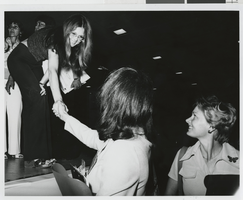Search the Special Collections and Archives Portal
Search Results

Transcript of interview with Fluff LeCoque by Joyce Marshall, May 5, 1997
Date
Archival Collection
Description
This interview is compiled in the bound book version for OH-02270. Born Ffolliott Chorlton in Butte, Montana in 1923, Fluff Le Coque embarked on a career during World War II that would span fifty-five years. Le Coque’s experience as an entertainer started at the age of seven when she began dance lessons during the Great Depression. She expanded her interest in show business at the University of Washington. Attending on a drama scholarship, she performed in theatrical productions and supplemented the scholarship by teaching coordination to university athletes through dance. Le Coque toured as a dancer in a road company during World War II. After the war she came to Las Vegas for the first time. Although she did not consider herself a singer, she performed as a vocalist with the Chuck Gould Orchestra at the Last Frontier. After a brief excursion to Hollywood, she returned to Las Vegas to work at the Thunderbird Hotel as a dancer. It was at the Thunderbird that she became part of the glamour publicity that would help shape the image of Las Vegas. Crowned “Miss Thunderbird,” Le Coque took part in publicity photo shoots designed to attract vacationing customers to the Las Vegas resort casino. While performing at the Thunderbird, Le Coque learned of an opportunity to showcase her talents in a wider arena. She joined a touring company that was preparing to take the production of Hollywood Extravangza to Europe. In Paris, Le Coque took on additional responsibilities in the production end of the business. She served the Hollywood Extravaganza as principal dancer, choreographer, and ballet mistress. On her return to New York, she firmed up her career-long relationship with producers Donn Arden and Ron Fletcher. Le Coque’s association with Arden-Fletcher Productions proved beneficial for an already successful career. She performed as principal dancer for Arden and Fletcher beginning with a six-month engagement at the Lookout House in Cincinnati, Ohio, in the late 1950s Arden wanted her to return to Las Vegas and she accepted immediately. The Las Vegas Desert Inn opened a newly remodeled showroom with Fluff Le Coque as a featured principal dancer. Arden-Fletcher Productions kept a number of performers busy throughout the United States from California to New York. Le Coque, now a valued talent, appeared in the Arden-Fletcher production at the Moulin Rouge in Hollywood. She worked there as company captain and principal dancer for ten years. Following her extended engagement at the Moulin Rouge, she toured the United States and Europe before returning to Las Vegas for good in the late 1960s. Arden again asked her to open a renovated showroom at the Desert Inn and again she agreed. This time Le Coque made Las Vegas her permanent home. She danced until she was forty-five years old and during the later years worked both sides of the stage, as company manager and dancer. Fluff Le Coque retired from dancing in 1970 to enjoy leisure activities and volunteer work. She learned to paint and served as publicity director of the Las Vegas Art Museum. She was wooed out of retirement by Donn Arden, to become company manager of the production show at the new MGM Grand Hotel [later reopened as Bally’s]. At the time of the interview, Le Coque continued to serve as company manager for Jubilee at Bally’s Hotel & Casino. Le Coque’s narrative provides a vivid account of the history of the Las Vegas entertainment industry. In addition to the organization of club circuits during the post-war years, the narrative provides clues about white-black relations during the era. It also informs a wider historical context. Post-war American society underwent significant changes economically, politically, and socially. Expanded work opportunities for women were among those changes. Le Coque’s choice to complete a college education during the 1940s was atypical. Her successful dancing career and later move into production management provides an example of career achievement decades ealier than the majority of American women. By extending her career as a dancer into her forty-fifth year, she resisted the evolving publicity hype that only an ingenue could be a dancer. Her narrative provides a compelling description of both the glamour and physical demands associated with the Las Vegas entertainment industry.
Text
Claudine Williams oral history interview
Identifier
Abstract
Oral history interview with Claudine Williams conducted by Joanne Goodwin on November 20, 1997 and November 09, 2005 for the Women's Research Institute of Nevada (WRIN) Las Vegas Women Oral History Project. Goodwin begins the interview by discussing growing up in Shreveport, Louisiana, and how she supported her single mother. She goes on to describe her education and early jobs in restaurants and newsstands in Texas. Goodman then talks about meeting her husband, Shelby Williams, and how she became involved in the gaming industry, including her work with Benny Binion in Dallas, Texas and Jake Freidman in Houston, Texas. She describes moving to Las Vegas, Nevada in 1963, and how she and Shelby developed the Silver Slipper Casino, which was sold to Howard Hughes, and Holiday Casino, which eventually became Harrah's Hotel and Casino. Williams also speaks about her community involvement, including philanthropic efforts at the University of Nevada, Las Vegas.
Archival Collection

Photograph of Gloria Steinem, Las Vegas (Nev.), June 18, 1977
Date
Archival Collection
Description
Image
Felicia Campbell oral history interview
Identifier
Abstract
Oral history interview with Felicia Campbell conducted by Kendra Gage on June 28, 2012 for the Boyer Early Las Vegas Oral History Project. In this interview, Campbell discusses her career in education and her advocacy for equal pay for women employees of the University of Nevada, Las Vegas. She begins by briefly discussing her family history and her education before moving to Las Vegas, Nevada in 1962 to take a professorship at the newly established University of Nevada, Las Vegas. Campbell describes discovering the disparities between the salaries of female professors and male professors, organizing the women faculty on campus, establishing the Women's Caucus, and the litigation she faced from the University of Nevada, Las Vegas. Campbell also talks about her travels, other issues as they relate to labor and women's rights, and founding the first chapter of the National Organization of Women (NOW) in Las Vegas.
Archival Collection
Anna Bailey oral history interview
Identifier
Abstract
Oral history interview with Anna Bailey conducted by Claytee White on March 03, 1997 for the Women's Research Institute of Nevada (WRIN) Las Vegas Women Oral History Project. Bailey opens her interview by describing her early life, family, and dance training. She discusses moving to Los Angeles, California at age fifteen, her first dancing gigs, and touring in London, England. She also talks about her experiences as an African American dancer including issues with segregation while touring in the southern United States. Bailey then discusses her life in Las Vegas, Nevada in the 1950s, and working as a dancer at the Moulin Rouge. She describes the club, the other dancers that performed there, and how the African American community felt when the club closed. Bailey then discusses how her husband and the entertainers Josephine Baker and Frank Sinatra helped integrate Las Vegas. She ends her interview by describing the last hotel she danced at, the Flamingo, where she performed in an integrated dance line.
Archival Collection
Musiette McKinney oral history interview, 2024 July 02
Level of Description
Scope and Contents
Oral history interview with Musiette McKinney conducted by Stefani Evans and Claytee D. White on July 2, 2024 for Game On! The Oral History of Las Vegas Sports project. In this interview, Musiette KcKinney recalls a childhood in Illinois and Pomona, California. She describes being recruited out of high school to play at California State Polytechnic University, Pomona in 1975, and then being drafted to the San Francisco Pioneers, an expansion team in the first women's professional basketball league, the Women's Basketball League. Returning to Pomona, McKinney coached basketball part time for Mount San Antonio Community College (Mt. SAC) and earned her A.A. in Criminal Justice. In 1992, McKinney arrived in Las Vegas, Nevada as UNLV's Assistant Women's Basketball Coach for four years under Head Coach Jim Bolla. After two years at the Andre Agassi Academy, McKinney returned to UNLV to work with the Center for Academic Enrichment & Outreach. McKinney was inducted into the Women's Basketball Hall of Fame with her former team, the San Francisco Pioneers, and the entire Women's Professional Basketball League as "Trailblazers of the Game." Digital audio and photographs available.
Archival Collection
Collection Name: Game On! The Oral History of Las Vegas Sports Interviews
Box/Folder: Digital File 00
Archival Component
Toni Clark oral history interview
Identifier
Abstract
Oral history interview with Toni Clark conducted by Joanne L. Goodwin on July 02, 1996 for the Women's Research Institute of Nevada (WRIN) Las Vegas Women Oral History Project. Clark opens her interview describing her childhood in Seattle, Washington. Clark then discusses moving to San Diego, California in 1941 and becoming a waitress at the Monte Carlo bar and restaurant. Clark then discusses how war rationing affected daily life and the nightclub industry. Clark then talks about marrying Wilbur Clark, moving with him to Las Vegas, Nevada in 1944, and the history of the El Rancho Vegas. Clark discusses the opening of the Monte Carlo Club, living in Las Vegas in the 1950s, and the opening of the Desert Inn Hotel. Clark goes on to describe the management of the Desert Inn, the food, and lounges. Clark then mentions the celebrities she has met and entertained, and the opening of the Flamingo Hotel.
Archival Collection

Transcript of interview with Renee Marchant Rampton by Dr. Caryll Batt Dziedziak, September 25, 2015
Date
Archival Collection
Description
Renee Marchant Rampton has often referred to herself as "One of Fifteen." Indeed, growing up in a family of fifteen children, Renee experienced the care of loving parents, the excitement of a bustling household, and the engagement of an active Church; all amidst the strains of a depression era economy. Renee's mother, Beatrice Marchant, provided Renee with a strong role model with which to emulate; a disciplined woman, who rose to the task without hesitation. Beatrice became the family's provider after her husband's debilitating stroke and later served in the Utah Legislature during the 1970s. Renee loved music from an early age. As a young child she found an early job as a piano accompanist for a dance studio. In 1956 she married musician, Roger Rampton, a successful percussionist. They soon settled in Las Vegas, where Roger performed on the Strip and they began raising their four children. It was an exciting period in Las Vegas history as the Strip attracted musicians and
Text

Transcript of interview with Rachel Gibson by Kay Long & Caryll Batt Dziedziak, August 25, 1998
Date
Archival Collection
Description
Rachel Gibson was the granddaughter of Nevada pioneers. Her maternal grandparents, George Rammelkamp and Anna Dougherty, were among the earliest white residents of northern Nevada, settling first in Dayton and later Yerington. Her mother, Clara Angelina, and her two aunts, Elizabeth and Georgie, graduated from the University of Nevada at the turn of the century. Clara taught in Yerington for a number of years before marrying Chase Masterson, a dentist. Rachel was born in 1913 in Yerington. The eldest of three children, she continued the tradition of women’s learning and education that began with her mother’s generation. Her 1930 class was the first to graduate from Las Vegas High School, and soon after Rachel moved to California to attend college. Although her father had counseled her to study law, Rachel chose the field of economics. She received her Bachelor’s degree from the University of California at Berkeley, and worked in San Francisco for one year before returning to complete
Text
Alice Key oral history interview
Identifier
Abstract
Oral history interview with Alice Key conducted by Claytee D. White on February 17 and March 24, 1997 for the Women's Research Institute of Nevada (WRIN) Las Vegas Women Oral History Project. In this interview Alice Key discusses being a chorus line dancer at the Cotton Club in Culver City, California and then moving to Las Vegas, Nevada after her dancing career ended. She then talks about working as a reporter, her involvement with the civil rights movement in Las Vegas, and creating the first all-black television show in the country: Talk of the Town.
Archival Collection
